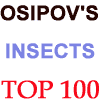Sphinginae subfamily
Sphingini tribe:
 |
Agrius cingulata,
WO Pink-spotted Hawkmoth:
Convolvulaceae family:, especially
Ipomoea batatas (sweet potato); Solanaceae family:
especially (Datura) (jimsonweed) and related plants in
Americas. Also a brown form. Look for very large, dark
spiracular circles. likely as an adult stray; unlikely as larva
|
 |
Lintneria separatus
TJ, Separated Sphinx. Salvia greggii has been confirmed as a larval host
by Robert A. Behrstock. Jim Tuttle, tentative id, writes, "All of the
penultimate instars of both Lintneria (Sphinx) istar and Lintneria (Sphinx) separatus that I have reared have been mundane green."
|
Lintneria separatus, near Flagstaff, September 19, 2016, Kara Jensen.

|
Manduca quinquemaculatus
BAMONA,
Five-spotted Hawkmoth.
Tomato Hornworms: each has a black horn at the end of abdomen.
Potato, tobacco, tomato, and other plants in the
nightshade family (Solanaceae). Most larvae are green, but there is also a very beautiful brown
form to the left.
|
 |
Manduca rustica
WO, Rustic Sphinx.
The caterpillar has numerous white nodules on top of thorax and
seven pairs of oblique, blue-gray stripes along body side.
Horn is white at base; blue-gray at tip. Many hosts.
|
 |
Manduca sexta
WO, Carolina Sphinx.
Tobacco Hornworms, equipped with a red-tipped horn at the end of the
abdomen, are true gluttons and feed on tobacco and tomato, and
occasionally potato and pepper crops and other plants in the
nightshade family (Solanaceae).
|
 |
Sagenosoma elsa
BAMONA, Elsa Sphinx. Larval hosts are unknown, but larvae probably feed on Lycium
in the nightshade family (Solanaceae).Note the strong oblique black lines and the black anal horn.
|
 |
Sphinx asellus
BAMONA, Asella sphinx.
Larval hosts are Manzanita and Arctostaphylos
of the Ericaceae family. Look for a blue horn and strong purple
colouration.
|
 |
Sphinx chersis
BAMONA, Great Ash Sphinx. Larvae: pale bluish green. Head with pair of yellow
lateral bands meeting at the apex. Larval hosts are ash, lilac, privet, cherry, and quaking aspen.
|
 |
Sphinx dollii BAMONA, Doll's sphinx:
Alligator juniper (Juniperus deppeana), other juniper species. It is amazing to me how well the larval
spiracular patches and false feet match the pattern and colour of the juniper bark.
|
 |
Sphinx libocedrus BAMONA,
Incense Cedar Sphinx. New Mexican forestiera
(Forestiera neomexicana), Forestiera angustifolia,
little leaf ash (Fraxinus gooddingii) in Oleaceae
family. Green and dark forms; larvae tend to darken just before pupation.
|
 |
Sphinx vashti
BAMONA,
Snowberry Sphinx.Larvae feed on the common snowberry (Symphoricarpos albus)
and on coralberry (S. orbiculatus). Note the two golden
lines of slightly raised bumps, one just behind the head, the other
on the thorax.
|
Smerinthini Tribe:
 |
Pachysphinx occidentalis
WO,
Big Poplar Sphinx.
Larvae feed on cottonwood and poplar (Populus) and willow
(Salix).
Larvae are very chunky with little to distinguish them
from Pachysphinx modesta.
|
 |
Paonias excaecata
BAMONA,
the Blinded Sphinx.
Larvae accept willows, birches, and cherries.
I have also found them in the wild on oak in eastern Canada.
Skin is quite granulous.
|
 |
Paonias myops
BAMONA,
Small-eyed Sphinx.
Wild cherry species are the favorites as larval
foodplants, but eggs will also be deposited on birches and other
forest trees. To the left a second/third instar larva rests on pin
cherry. The "red heart" marking readily identifies this species.
generally more eastern species; possibly |
 |
Smerinthus cerisyi
BAMONA,
Cerisy's Sphinx; Greatly resemble modesta larvae, both pale
green, with granular skin, pale lateral diagonal lines, faint red
spiracular circles, very pale longitudinal lines running from
head to more pronounced anal diagonal line.
Green heads bounded dorsally with pale yellow inverted "V".
|
 |
Smerinthus saliceti
WO, Salicet
Sphinx, flies in valleys and along streamsides from Mexico City north
to west Texas, southern Arizona, and extreme southern California.
There are two colour morphs, one pale green; one lime green.
Willow (Salix) or poplar (Populus).
|
Macroglossinae subfamily
Dilophonotini tribe:
 |
Erinnyis crameri, Cramer's Sphinx,
WO.
Various plants in the dogbane family
(Apocynaceae): Rauvolfia ligustrina, Rauvolfia tetraphylla,
Stemmadenia obovata. There is also a brown form.
likely as an adult stray; unlikely in larval stage.
|
 |
Erinnyis ello
WO, Ello Sphinx.
Papaya (Carica papaya), Cnidoscolus
angustidens, poinsettia (Euphorbia pulcherrima),
guava (Psidium species),
saffron plum (Bumelia angustifolia/Bumelia celastrina).
Manilkara bahamensis,
Willow Bustic (Bumelia salicifolia)
and Painted Leaf (Poinsettia heterophylla) are also hosts.
Nice socks! Very variable.
|
 |
Erinnyis obscura, Obscure Sphinx,
WO.
Rauvolfia ligustrina, Rauvolfia tetraphylla,
Stemmadenia obovata, Philibertia, Cynanchum, papaya
(Carica papaya), Asclepiadaceae, Blepharodon mucronatum,
White vine (Sarcostemma clausum) and Morrenia odorata.
|
 |
Hemaris thetis
BAMONA
Snowberry (Symphoricarpos),
honeysuckle (Lonicera), Coralberry, viburnums, high bush cranberry, hawthorn (Crataegus).
Horn: black with slightly lighter base. This western species was formerly classified as
H. diffinis or H. senta. Those species west of the Continental Divide are
H. thetis.
|
Philampelini tribe:
 |
Eumorpha achemon
BAMONA, Achemon Sphinx.
Grape (Vitis), Virginia Creeper (Parthenocissus quinquefolia) and other vines and ivies (Ampelopsis).
Larvae occur in both a light (green) form and a darker (tan/brown) form. Note six "segmented" oblique lines.
|
Macroglossini tribe:
 |
Euproserpinus wiesti, BAMONA, Wiest's Primrose Sphinx:
Day flyer over sand washes, prairie blow-outs as single brood from May-June. Prairie primrose (Oenothera latifolia) in evening
primrose family (Onagraceae).
Captive rearing difficult. Larvae need sunshine, heat, humidity.
|
 |
Hyles lineata
BAMONA, White-lined Sphinx.
Highly varied and feed on a great diversity of plants
including willow weed (Epilobium), four o'clock (Mirabilis),
apple (Malus), evening primrose (Oenothera), elm
(Ulmus), grape (Vitis), tomato (Lycopersicon),
purslane (Portulaca), Fuschia.
All larvae seem, however, to have red/black swellings split by
dorso-lateral lines. |
|
 |
Proserpinus juanita BAMONA, Juanita Sphinx:
Newly-hatched caterpillars eat eggshells. (Onagraceae) including evening primrose (Oenothera), gaura (Gaura),
and willow weed (Epilobium). Michael Van Buskirk has found them on Guara biennis in Missouri. rare
|
|


























